The Athlon II X2 & Phenom II X2: 45nm Dual-Core from AMD
by Anand Lal Shimpi on June 2, 2009 12:00 AM EST- Posted in
- CPUs
3dsmax 9 - SPECapc 3dsmax CPU Rendering Test
Today's desktop processors are more than fast enough to do professional level 3D rendering at home. To look at performance under 3dsmax we ran the SPECapc 3dsmax 8 benchmark (only the CPU rendering tests) under 3dsmax 9 SP1. The results reported are the rendering composite scores:
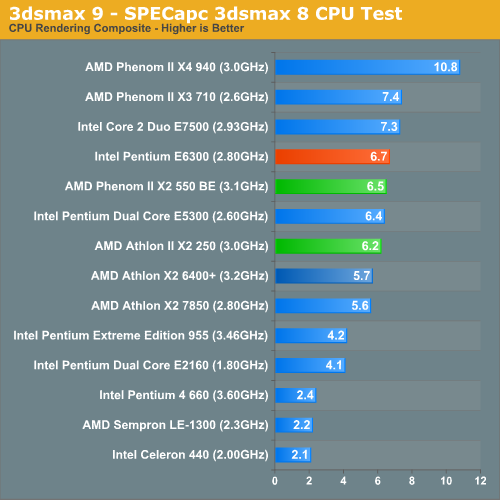
In 3dsmax, the E6300 pulls ahead of the Phenom II X2 550.
Cinebench R10
Created by the Cinema 4D folks we have Cinebench, a popular 3D rendering benchmark that gives us both single and multi-threaded 3D rendering results.
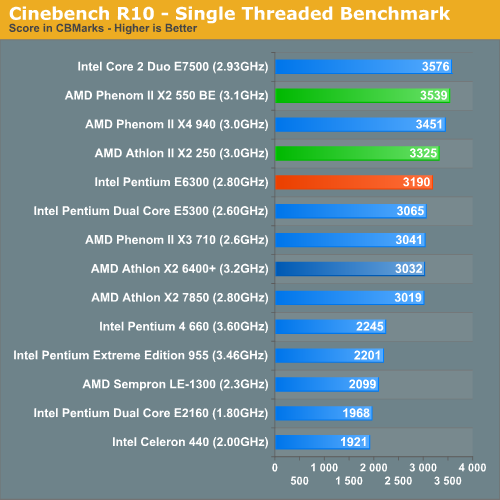
Cinebench has both AMD newcomers outperforming Intel's E6300.
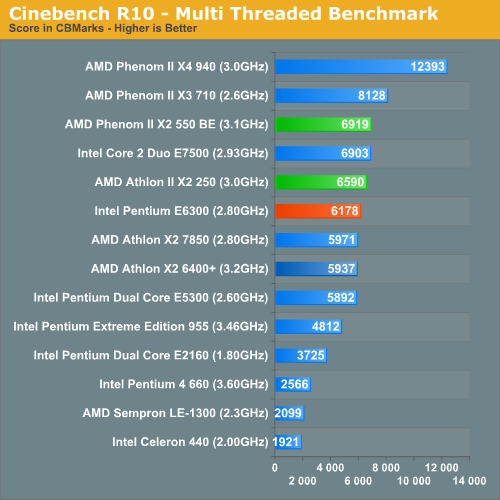
POV-Ray 3.73 beta 23 Ray Tracing Performance
POV-Ray is a popular, open-source raytracing application that also doubles as a great tool to measure CPU floating point performance.
I ran the SMP benchmark in beta 23 of POV-Ray 3.73. The numbers reported are the final score in pixels per second.
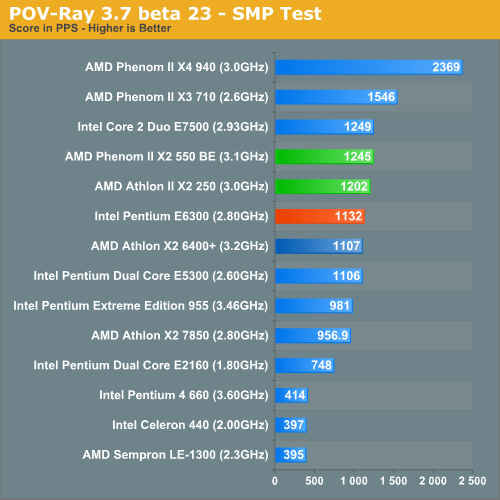
POV-Ray has the E6300 behind its AMD competitors once again. The margins are pretty close, especially when you realize that there's virtually no performance difference between the Athlon II X2 250 and the Phenom II X2 550 BE.
Blender 2.48a
Blender is an open source 3D modeling application. Our benchmark here simply times how long it takes to render a character that comes with the application.
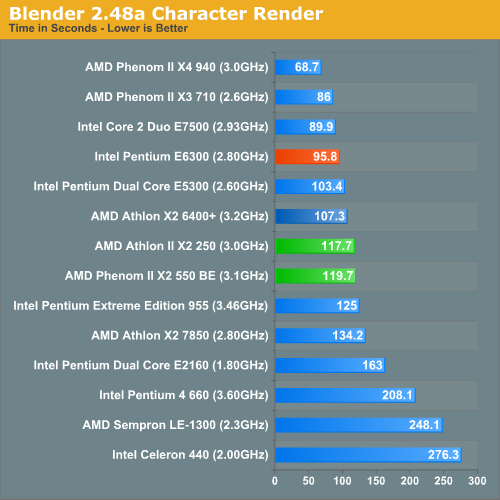










55 Comments
View All Comments
Gary Key - Tuesday, June 2, 2009 - link
The X2 6400+ is in the charts now and you can always use our Bench tool to compare a whole litany of processors against each other. AMD is currently phasing out of 90nm production and even several 65nm products will be phased out this year as they ramp the 45nm production.Spoelie - Thursday, June 4, 2009 - link
WOW, it really amazes me how little performance has improved. Athlon II X2 750 (3ghz) is barely faster in most benchmarks than a Athlon X2 6400+ (3,2ghz), and loses in 1 or 2.So the phenom core redesign buys around 300mhz around 3ghz, or only 10%. Everything else that improved in phenom is uncore.
And this while the original is at 90nm and the new one is 45nm, what a waste of potential. It seems to me AMD could've tried a little harder with the Athlon II.
Spoelie - Tuesday, June 2, 2009 - link
There's a small util/service out there that brings phenom II cnq behaviour from vista over to windows xp (phenom II's cnq behaves like phenom I's cnq under windows xp). It does this by disabling standard cnq (set power management not on "minimal") and implementing pstate changing itselfhttp://home.comcast.net/~pmc650/site/?/page/CNQ_Ph...">http://home.comcast.net/~pmc650/site/?/page/CNQ_Ph...
Maybe it can do the same for the Athlon II X2 on vista...
mohindar - Tuesday, June 2, 2009 - link
Hello Anand,It will be very nice to provide some benches regarding desktop virtualization, like how windows-xp usage on this chip and so on...
plonk420 - Tuesday, June 2, 2009 - link
i'm curious to see this on the bench!mapesdhs - Tuesday, June 2, 2009 - link
I'm beginning to wonder whether AMD/Intel are making the same mistake
we saw last year with gfx cards, ie. too many different options. What
is the target market for the new AMD CPUs? Many retailers seem to
offer just a small selection.
Any chance you could add an i7 920 and a 6000+ to the tables please?
The former for completeness, the latter to show how the newer AMD
parts stack up against a typical older product. I'd been hoping for
a suitable replacement for the 6000+ in my ASUS board, but still nothing (no BIOS support).
Atm it looks like my next system will be an i7 920 setup (core task
is video encoding). In the past there's been lots of talk about the
higher cost of an i7 system, but looking around yesterday, I was
surprised at how small the difference has now become. The i7 920 is
only 18% more than the Ph2 955 BE. Expecting a larger difference for
the mbd cost, I found an X58 board from Gigabyte (the GA-EX58-UD3R,
135 UKP from LambdaTek) right in the middle of the price range of
typical AM3 boards. They both use DDR3, so that isn't a factor. I
was going to build a Ph2 955 BE system for my brother as his next
gaming rig, but with such small price differences now in play, the
i7 looks more sensible.
Oh, a typo on the first page perhaps? Surely it should be 2 cores for
the Athlon64 X2?
Ian.
smilingcrow - Tuesday, June 2, 2009 - link
Judging by other reviews your choice of using the x264 HD Bench Pass 1 for the Power Consumption comparison doesn’t give a true representation of the situation.As expected other reviews shows the Athlon II X2 having a noticeably lower power consumption under typical loads.
The Phenom II X2 has too much extra circuitry to have lower power consumption and I’m surprised that you didn’t deduce that something was amiss.
Anand Lal Shimpi - Tuesday, June 2, 2009 - link
As I mentioned on the power consumption page, I'm guessing it has more to do with the current level of BIOS support for the Athlon II's power management. AMD is expecting a much better situation in the coming weeks.Take care,
Anand
Eeqmcsq - Tuesday, June 2, 2009 - link
The one comparing various Athlon X2 specs. The table says the Athlon 64 X2 has 4 cores.Anand Lal Shimpi - Tuesday, June 2, 2009 - link
Woops, thank you :)-A